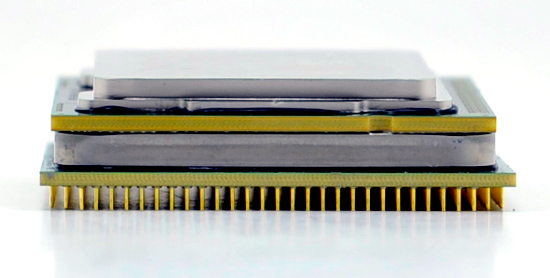Intel's Core i7 870 & i5 750, Lynnfield: Harder, Better, Faster Stronger
by Anand Lal Shimpi on September 8, 2009 12:00 AM EST- Posted in
- CPUs
Final Words
I'll start this conclusion with what AMD must do in response to Lynnfield. The Core i5 750 is a great processor at $196, in fact, it's the best quad-core CPU you can buy at that price today. In nearly every case it's faster than AMD's Phenom II X4 965 BE, despite the AMD processor costing almost another $50. Granted you can probably save some money on an integrated 785G motherboard, but if you're comparing ~$120 motherboards the AMD CPU is simply overpriced.

Lynnfield (top) vs. Phenom II (bottom)
Luckily, the solution isn't that difficult. AMD needs to lower prices. The problem is that AMD has too many products below $200 already. The Phenom II X3 and X4 series both exist below $200 and rumor has it that AMD is also going to introduce a quad-core Athlon II somewhere down there. Lynnfield's arrival causes a lot of price compression on AMD's side. The most AMD should sell the 965 BE for is $199, but if it is to remain competitive the chip needs to be priced much lower. That doesn't leave much room for other AMD CPUs. On the bright side, this could force AMD to simplify its product lines again (similar to what it has quietly been doing already).

The next thing that the Core i5 750 does is it finally ends the life of LGA-775. Just as was the case with AMD, the Core 2 Quad Q9650 is easily destroyed by the Core i5 750 and at a lower price. With significantly lower motherboard costs than the LGA-1366 chips, the Core i5 750 can actually compete in the high end LGA-775 space. It's only a matter of time before the sub-$200 LGA-775 parts are made obsolete as well.
Lynnfield power consumption is just excellent, these are the most power efficient quad-core CPUs we've ever tested. They use less power at idle than similarly clocked dual-core processors and under load they deliver better performance per watt than any of their closest competitors. Later this year we'll see 32nm dual-core Westmere start to ship for notebooks. I don't have performance data but I'd expect that early next year will be the perfect time to buy a new notebook.
Can you tell that I like the Core i5 750? Again, at $196 you can't find a better processor. Intel did its homework very well and managed to deliver something that kept AMD in check without completely upsetting the balancing of things. There's no technical reason that Intel couldn't have enabled Hyper Threading on the Core i5, it's purely a competitive move. A Core i5 750 with HT would not only defeat the purpose of most of the i7s, but it would also widen the performance gap with AMD. Intel doesn't need to maintain a huge performance advantage, just one that's good enough. While I'd love to have a 750 with HT, I'd still recommend one without it.
The Core i7 870 gets close enough to the Core i7 975 that I'm having a hard time justifying the LGA-1366 platform at all. As I see it, LGA-1366 has a few advantages:
1) High-end multi-GPU Performance
2) Stock Voltage Overclocking
3) Future support for 6-core Gulftown CPUs
If that list doesn't make you flinch, then Lynnfield is perfect. You'll save a bunch on a motherboard and the CPUs start at $196 instead of $284. We didn't have enough time with our Core i7 860 to include performance results here but my instincts tell me that at $284 that'll be the Lynnfield sweetspot. You get excellent turbo modes and Hyper Threading, without breaking $300.
Speaking of turbo, I'd say that Intel is definitely on to something here. The performance impact was small with Bloomfield, but turbo on Lynnfield is huge. My tests showed up to a 17% increase in performance depending on the workload, with most CPU-influenced scenarios seeing at least 9 or 10%. The turbo mode transitions happen fast enough to accelerate even simple actions like opening a new window. OS and application responsiveness is significantly improved as a result and it's something that you can actually feel when using a Lynnfield machine. It all works so seamlessly, you just always get the best performance you need. It's like Intel crammed the best single, dual and quad-core processors all into one package.
Perhaps that's what kept me from falling in love with Bloomfield right away. It was fast but in the same way that its predecessors were fast. If you didn't have a well threaded application, Bloomfield wasn't any better than a similarly clocked Penryn. Lynnfield's turbo modes change the game. Say goodbye to tradeoffs, the Core i5 and Core i7 are now fast regardless of thread count. It speed that is useful, it speed that you can feel, it's what truly makes Lynnfield the best desktop microprocessor of 2009. It's not just faster, it's smarter, it's better. It's why today's title borrows from Daft Punk and not Star Wars; it's not more of the same, it's something futuristic and new.
Lynnfield shows us the beginning of how all microprocessors are going to be made in the future. Even AMD is embracing turbo, we'll see it with Fusion in 2011. Extend turbo to its logical conclusion and you end up with something very exciting. Imagine a processor made up of many different cores, large and small, CPU and GPU. Each one turning on/off depending on the type of workload, and each running as fast as possible without dissipating more heat than your system can handle.
My only two complaints with Lynnfield are that the chips do require additional voltage (above stock) to overclock and of course the lack of Hyper Threading on the Core i5. It doesn't ruin the processor, but it gives us something to wish for.
Our work is never over.










343 Comments
View All Comments
mschira - Tuesday, September 8, 2009 - link
I wonder if a 4xPCIe RAID adapter directly connected to a PCIe slot that is connected to the CPU is any faster than it is for a Core i7 920....Cheers
Gary Key - Tuesday, September 8, 2009 - link
Less than a one percent difference in my testing so far.Jamahl - Tuesday, September 8, 2009 - link
Why do your benches falsely state 2.66ghz when they are clearly running faster than that?rbbot - Tuesday, September 8, 2009 - link
lol - I've just been berating a reviewer on another site for benchmarking with turbo off! In that case the review wasn't targeted at an overclocking audience, but even here I can't see the argument for benchmarking with it disabled.Yes you do need to turn it off for extreme overclocking, but this review is comparing the chips in their stock configuration and stock configuration is on.
maxxcool - Tuesday, September 8, 2009 - link
As for false, well gee, you were told it was on. Didn't you read that? or are you snakeoils brother?goinginstyle - Tuesday, September 8, 2009 - link
They list the base CPU speeds, it was discussed clearly in the article that turbo is enabled, it is not a false statement for reporting what you will purchase. Apparently you just want to flame bait here and I hope they ban you and the two other nut jobs.rgallant - Wednesday, September 9, 2009 - link
people see what they want to see I guess-I wanted to see the multi gpu test, 1156 vs 1366 , clock vs clock ,fps vs fps ,16x vs 8x on die , not one chip overclocking it's self unless you show the numbers for turbo on and off, what if the 1366 mb used for the benches came out of the box and by the default bios overclocked the i7 920 to 3.8 ,would those numbers be included as stock out of the box. I don't think so , that feature would be turned off on the mb.for the benches. 1156 numbers could mean nothing really.
-all cpu's should been locked at 3.6 at least for the multi gpu test or one test anyways.
-the 8x 8x lane issue is the only crippled feature on the new chips ,and it seems to take a back seat to the $50.00 savings for a mb for a $600.00 i7 870 chip ,or $900.00 CND .lol On sept.05 my local shop had the i7 920 D0 and the i7 860 both at $345 CND.
-good review as always ,just missing that part for me , looking to commit on a 1156 or a 1366 upgrade.
maxxcool - Tuesday, September 8, 2009 - link
Yeah, you got to get rid of snakeoil, he is quiet the troll on the TechReport forums as well. He has been banned from several sites already.andrenb91 - Tuesday, September 8, 2009 - link
i5 is faster than PII's! but gotta wait for the lower end ones come outbecause these $190+ chips aren't the one ones that brings up revenue for companies like amd or intel...of course intel has the upper hand here, it could use as a propaganda do deliver up the slower parts. Amd has value and some good cpus at the lower end... that ones bring profits to the company,amd strategy is looking good for now, but it's design must change (native dual/tripe core versions of Phenom II) and the die size have to get smaller to compete next year (against 32nm low end ones...) well I use amd budget ones, for what I do is good enough, ( thin about $400 pc in USA, live in Brazil...) still, I can play some 40fps games and do some video encoding with my gpu,my point is, amd still have the lower-end market, the problem is, if were some of that people that think pentium is a company name, I would by the pentium cpus instead of amd strange cpus. that's why intel sells a lot more desktops and notebooks, of course the performace is great at some 700+ pcs and laptops, but amd has the lower-end, and there it is what amd is looking for: market share, and taht will pump amd back again by 2011 with its fusion apu, intel already controls 80% of mainstream,and high-end markets, but doesn't have a player for the lower-end, thats what I'm looking for a good old intel cpu that beats p2x3 or athlonIIx4 by intel at about $100. then I'll buy my next cpu, probably an intel, or continue with Amd, time will tell...
andrenb91 - Tuesday, September 8, 2009 - link
sorry for my english and, these benchmarks are for windows only, over linux intel i5 will not have this crazy advantage at all, well but who of us uses linux anyway?(don't lie to me, it's a dual boot...) well my system specs are: phenomII x3 705e,4gb ddr3 1333,hd 4650 basicaly a low-end to mainstream..